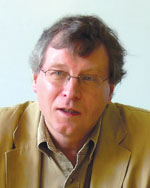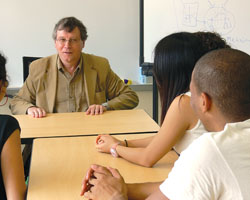Per Aage Brandt and his Students Extend
the SAGES Experience
art/sci 2006
 Last spring, if you had looked in on an undergraduate seminar taught by Per Aage Brandt, you would have noticed something unusual. Last spring, if you had looked in on an undergraduate seminar taught by Per Aage Brandt, you would have noticed something unusual.
The setting was a glass-walled classroom on the quad level of Crawford Hall, designed as a showcase for SAGES (Seminar Approach to General Education and Scholarship). At almost any hours of the day, this space provides a glimpse of the program in action— students gathered round a conference table, engaged in the kinds of discussions that have become the hallmark of undergraduate education at Case.
When Brandt's seminar was in session, though, the room was surprisingly crowded. With 25 students— more than the table could accommodate— extra chairs were placed along the walls. In SAGES courses generally, enrollment is capped at 17. But you would have sensed that, even in this densely populated seimar, no one was holding back or feeling overlooked.
Most of these students had worked with Brandt before. The previous fall, they were enrolled in his First Seminar—a semester-long exploration of “The Life of Mind.” But then, unlike most SAGES students, they had suggested making their next seminar a continuation of the first. This second course, “Signs and Symbols,” attracted several newcomers as well. So it was that a new and oversubscribed seminar came into being.
How the Mind Makes Meaning
Per Aage Brandt, the Emile B. de Sauzé Professor of Modern Languages and Professor of Cognitive Science, joined the Arts and Sciences faculty in 2005. A renowned and prolific scholar, he received the Grand Prix de Philosophie from the French Academy in 2002.
Brandt's research focuses on human beings’ use of signs—words, pictures, music, gestures—to represent aspects of the world or to communicate ideas and emotions. Accordingly, the discussion topics in his seminars covered the entire range of human thought and expression—everything from musical cadences to modernist painting to the hand movements of presidential candidates during a debate.
Last spring, In a series of sessions devoted to narrative, Brandt asked each of his students to tell a story—a folktale, a joke, a personal experience, a plot drawn from a novel or epic poem. Then the students talked about the meaning of each story and how they had gone about interpreting it. How are narratives structured, they asked, and how do we know when a story has come to an end? Why is it that other people are often better interpreters of our life stories than we are? To what extent do the stories we tell—to others and to ourselves—constitute our identities?
Brandt’s commitment to seminar learning began long before his involvement with SAGES. His first teaching position was at an experimental university in Denmark where instruction was entirely seminarbased. Later, as director of the Center for Semiotics at the University of Aarhus, he opened his seminars to students at all levels, from first-year undergraduates to Ph.D. candidates.
 In “the social atmosphere of the seminar,” Brandt says, it is possible both to impart elementary knowledge and to explore cutting-edge questions: “You let the more experienced students explain to the less experienced students what they need to know.” He also believes that a successful seminar must be “openended.” The students’ interests will help determine the sequence of topics and activities, and events outside the seminar will affect what occurs within it. In “the social atmosphere of the seminar,” Brandt says, it is possible both to impart elementary knowledge and to explore cutting-edge questions: “You let the more experienced students explain to the less experienced students what they need to know.” He also believes that a successful seminar must be “openended.” The students’ interests will help determine the sequence of topics and activities, and events outside the seminar will affect what occurs within it.
Last spring, when Muslims throughout the world denounced a Danish newspaper’s publication of cartoons depicting the prophet Muhammad, Brandt and his students began examining the semiotics of religion. Images of the deity are venerated in some traditions, forbidden in others. What does it tell us about human cognition and culture that these images are imbued with such power? As violent protests against the cartoons spread to several Muslim countries, Brandt pointed out to the class that national symbols were involved along with religious ones: on the news each night, there were demonstrators setting fire to the Danish flag.
SO MANY IDEAS
“I think Professor Brandt captures the essence of what a true seminar is,” says Eric Chen, one of the students who first participated both semesters. “We didn’t exactly follow the syllabus, which may come as a surprise to a lot of people.”
Chen and other students said that they enjoyed exploring topics in depth, instead of rushing through a prescribed curriculum. For one assignment, each student wrote an essay about identity, and then produced a summary to be read aloud and discussed in the seminar. “We went along at a pace of one or two students per class,” Chen recalls. “But we learned so much, because people had so many ideas, so many varied interpretations. It made me think in ways I never thought I would.”
Cierra Chiwanga signed up for “Signs and Symbols” without realizing that it was the continuation of an earlier course, but she says that she had no trouble fitting in. The first time Brandt assigned a group project, he mingled veterans and newcomers, and in this way a community of learners developed.
“We know each other better than we did back then,” says Yefim Vilnits, another student from the seminar. “We’re basically all friends now, and that makes for a different environment. It’s livelier now than it was before.”
For his part, Brandt sees the seminar as a way for students to make both social and intellectual connections. “SAGES creates a cross-disciplinary setting for thinking,” he explains. “It is different from their disciplines, where they have to take tests and give evidence of the development of their technical knowledge. Even in the humanities, it’s the same situation: they need a place where basic thinking can be done, where it is natural to stop and ask for the meaning of concepts.”
As he describes his own innovations as a SAGES instructor, Brandt pauses and permits himself a wry smile. “I have, of course, had a little difficulty fitting into the bureaucratic side of things,” he says. “But people have been very merciful.” |